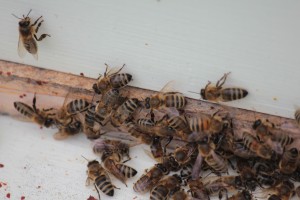Typically in my breeding program I start the season selecting from the best of my survivor stock. I try and select from lines that have stood out in years past and appear to have heritable traits. This does include evaluating the daughters of each breeder and how they wintered. The breeder stock can be from naturally mated or instrumentally inseminated queens.
Every year I try to better my stock by carefully adding pure VSH semen from the stock maintained by the USDA at Baton Rouge, LA. Bob Danka is the point of contact and has been helpful beyond words with my work. Although VSH is not the total answer to the mite issue, I believe it shouldn’t be overlooked. Most VSH hives die over the winter, but the few that survive have shown to be worth paying attention to. Usually a poor crop of winter bees leads to a small cluster size followed by death. In the fall as the queen begins to lay the final round of what will become the winter bees, the mites move into it as well. The VSH trait kicks in and most of this brood gets devoured and few winter bees are left. Semen selection used to be from a number of hives, but in recent years I do much better with only one or two selected from Bob’s favorites – just a thought to reduce the variability of daughters you produce. I don’t select for color, but the surviving color tends to be towards the “dark side”.
Several year back I did an exchange with Greg Hunt at Purdue. Please read about his work on the internet where he is selecting for bees that bite and injure varroa mites. They have become known as “ankle biters”. I created a number of daughter from his queens. Most were naturally mated with my survivor drone stock. Greg’s queens were only average egg layers, and it appears with one outcrossing into my stock this problem has vanished. It could be a little hybrid vigor surfacing. I plan to instrumentally inseminate from an old survivor line that may have this biting trait. Keep in mind my oldest survivor lines were doing something to manage mites before I added the VSH trait from the USDA. I look to this effort to be the single most important project in the coming year. Here, I plan to blend this trait into my stock covering several generations and begin a wide scale evaluation going into the fall. I will try and offer a number of these queens to beekeepers who are interested.
The Purdue work is now complete and overall very disappointing. I found myself apologizing for the queen cells and queens delivered to offsite people willing to test them at zero cost. The mite levels in the hives from the original Purdue queens was very high and whatever biting they carried seem to disappear in just a single outcross. Data based on feedback from individuals queens cells. I wish Greg the best, but from what I can tell this is work in progress. Perhaps the bees provided to me were not typical, but I can only report on what I worked with.
In the middle of the queen rearing season I begin to graft from queens that fall into the up and coming list. These are from hive that are just outstanding. The most important is low mite levels and a high stack of honey supers. I hope to have extra queens from this effort.
A list of specific breeders will be showing up in March.
